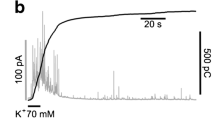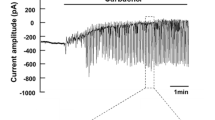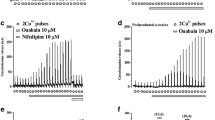Abstract
Using a Ca2+-sensitive fluorescent indicator, fura-2/AM, we recorded calcium transients in secretory cells of isolated acini of the rat submandibular salivary gland; these transients were induced by hyperpotassium-induced depolarization (after an increase in [K+] e up to 50 mM) of the plasma membrane of the above cells. Calcium transients were significantly suppressed by 50 μM nifedipine. Addition of 10 μM carbonyl cyanide m-chlorophenylhydrazone to the normal extracellular solution was accompanied by a rise in [Ca2+] i , whereas when hyperpotassium solution is used the effect was less expressed. Blockers of CA2+-ATPase in the cellular membrane and in the endoplasmic reticulum, eosin Y (5 μM) and cyclopiazonic acid (CPA, 5 μM), respectively, evoked a significant increase in [Ca2+] i and a decrease in the K+-depolarization-induced calcium transient. Extracellular application of caffeine (2, 10, or 30 mM) was accompanied by a concentration-dependent rise in [Ca2+] i . Therefore, potassium depolarization of the plasma membrane of acinar cells of the rat submandibular salivary gland activates both the voltage-dependent Ca2+ influx and Ca2+-induced Ca2+ release from the endoplasmic reticulum; the initial level of [Ca2+] i was restored at the joint involvement of Ca2+-ATPases in the plasma membrane and the membranes of the endoplasmic reticulum and mitochondria.
Similar content being viewed by others
REFERENCES
A. V. Tepikin and O. H. Petersen, “Functional organization of calcium stores in polarized secretory cells and transcellular calcium transport,” Neirofiziologiya/Neurophysiology, 29, Nos. 4/5, 252-255 (1997).
N. V. Fedirko and M. Yu. Klevets, “Evidence for steady-state Cà2+ influx into the secretory cells of Chironomus plumosus L. salivary glands and its role in spontaneous secretion,” Fiziol. Zh., 45, No. 4, 84-91 (1999).
P. Belan, J. Gardner, O. Gerasimenko, et al., “Isoproterenol evokes extracellular Ca2+ spikes due to secretory events in salivary gland cell,” J. Biol. Chem., 273, No. 17, 4106-4111 (1998).
R. J. Miller, “Voltage-sensitive Ca2+ channels,” J. Biol. Chem., 267, No. 3, 1403-1406 (1992).
M. Yu. Klevets and V. V. Man'ko, “Modification of voltage-dependent calcium channels of the membrane of secretory cells in a calcium-free solution,” Fiziol. Zh., 41, Nos. 3/4, 29-33 (1995).
M. Yu. Klevets, V. V. Man'ko, M. O. Galkin, et al., “Some aspects of the structural organization and functioning of the calcium channels and Na + /Ca 2+ exchanger in the membrane of secretory cells,” in: Experimental and Clinical Physiology (Collected Scientific Papers, Devoted to100th Anniversary of Department of Physiology, L'viv, October 10-14, 1995) [in Ukrainian], L'viv (1995), pp. 171-172.
I. Ogava, “Role of ryanodine receptors,” Crit. Rev. Biochem. Mol. Biol., 29, 229-274 (1994).
K. Mikoshiba, “Inositol 1,4,5-trisphosphate receptor,” Trends Pharmacol. Sci., 14, 86-89 (1993).
C. W. Heizmann and W. Hunziker, “Intracellular calcium-binding proteins: more sight than insights,” Trends Biochem. Sci., 16, No. 3, 98-103 (1991).
A. V. Tepikin, P. G. Kostyuk, V. A. Snitsarev, and P. Belan, “Extrusion of calcium from a single isolated neuron of the snail Helix pomatia,” J. Membrane Biol., 123, No. 1, 43-47 (1991).
S. A. Kosterin, T. V. Burdyga, V. P. Fomin, and A. K. Grover, “Mechanisms of Ca2+ transport in myometrium,” in: Control of Uterine Contractility, R. E Garfield and T. Tabb (eds.), CRC Press Boca Raton, New York (1994), pp. 129-153.
M. Yu. Klevets, V. V. Man'ko, and N. V. Fedirko, “Current of the Na + /Ca2+ exchange in the membranes of secretory cells of the salivary gland of Chironomus plumosus larvae,” Fiziol. Zh., 44, No. 3, 160-161 (1998).
J. Meldolesi, L. Madeddu, and T. Pozzan, “Intracellular Ca2+ storage organelles in nonmuscle cells: heterogeneity and func-tional assignment,” Biochem. Biophys. Acta, 1055, No. 2, 130-140 (1990).
A. Lundberg, “The electrophysiology of the submaxillary gland of the cat,” Acta Physiol. Scand., 35, 1-25 (1955).
V. I. Gutkin, “Effects of transmitters of the autonomic nervous system on polarization of secretory cells of the cat sub-maxillary salivary gland,” in: All-Union Symposium “Physio-logical Role of Transmitters” (Kazan', 1972), Kazan' (1972), pp. 74-75.
A. Nishiyama and M. Kagayama, “Biphasic secretory potentials in cat and rabbit submaxillary glands,” Experientia, 29, 161-163 (1973).
M. Yu. Klevets and M. F. Shuba, “Electrical characteristics of the plasma membrane of the salivary gland cells of Helix poma-tia,” Physiol. Zh., 6, 540-542 (1974).
M. Yu. Klevets, “Detection of the voltage-dependent K + channels in the plasma membrane of secretory cells,” Fiziol. Zh., 36, No. 4, 102-104 (1990).
M. Yu. Klevets, “Identification and properties of Cl voltage-dependent channels of the membranes of secretory cells,” Fiziol. Zh., 37, No. 2, 72-76 (1991).
M. Yu. Klevets and Z. V. Gural', “Identification of the depolarization-activated Ca2+ current in the membranes of secre-tory cells,” Fiziol. Zh., 36, No. 2, 102-104 (1990).
Y. Maruyama, O. H. Petersen, P. Flanagan, and G. T. Pearson, Qualification of Ca2+-activated K + channels under hormonal control in pig pancreas acinar cells,” Nature, 305, 228-232 (1983).
D. V. Gallacher and A. P. Morris, “A patch-clamp study of potassium currents in resting and acetylcholine-stimulated mouse submandibular acinar cells,” J. Physiol., 373, 379-395 (1986).
D. V. Gallacher and A. P. Morris, “The receptor-regulated calcium influx in mouse submandibular acinar cells is sodium dependent: a patch-clamp study,” J. Physiol., 384, 119-130 (1987).
F. Pfeiffer, L. Stenfeld, A. Schmid, and I. Schulz, “Control of Ca2+ wave propagation in mouse pancreatic acinar cells,” Am. J. Physiol., 274, No. 3, C663-C672 (1998).
G. Grynkiewicz, M. Poenie, and R. Y. Tsien, “A new generation of Ca2+ indicators with greatly improved fluorescence properties,” J. Biol. Chem., 260, 3440-3450 (1985).
T. V. Korol', V. V. Man'ko, and M. Yu. Klevets, “Effects of voltage-dependent Ca2+ channel blockers on hyperpotassium depolarization-stimulated influx of Ca2+ into the exocrine gland cells and their secretory responses,” Galyts'kyi Likar. Visn., 5, No. 3, 46-48 (1998).
G. L. Pedersen and O. H. Petersen, “Membrane potential measurement in parotid acinar cells,” J. Physiol., 234, 217-227 (1973).
V. L. Zyma, O. M. Dyachok, and V. V. Ganchurin, “Modification of a technique for studying free intracellular calcium,” Fiziol. Zh., 41, Nos. 3/4, 115-119 (1995).
E. Sher, A. Pandiella, R. M. Moreso, and F. Clementi, “Voltage-operated calcium-channel subtypes in human neuroblas-toma and rat pheochromocytoma cells,” Ann. New York Acad. Sci., 560, 249-250 (1989).
A. V. Shmigol' and E. P. Kostyuk, “Mechanisms responsible for the formation of calcium signals in murine primary sensory neurons: their impairment by experimentally induced diabetes,” Neirofiziologiya/Neurophysiology, 27, Nos. 5/6, 331-341 (1995).
N. Fedirko, M. Klevets, and Ju. Vats, “Isolated acini as an object for investigation of the Ca2+-transporting system of secretory cell membranes,” Neirofiziologiya/Neurophysiology, 32, No. 3, 183-184 (2000).
H. Karaki and G. B. Weiss, “Modification by decreased temperature and hypoxia of 45 Ca2+ movements in stimulated smooth muscle of rabbit aorta,” Gen. Pharmacol., 18, 363-368 (1987)
H. Karaki, H. Ozaki, M. Hori, et al., “Calcium movement, distribution and functions in smooth muscle,” Pharm. Rev., 49, No. 2, 157-254 (1996).
N. V. Fedirko and M. Yu. Klevets, “Effect of eosin Y and orthovanadate on steady-state Ca2+ influx into secretory cells of the exocrine glands and spontaneous secretion,” Physiol. Zh., 46, No. 6, 3-9 (2000).
N. Seidler, I. Jona, M. Vegh, et al., “Cyclopiazonic acid is a specific inhibitor of the Ca2+-ATPase of sarcoplasmic reticulum,” J. Biol. Chem., 264, No. 30, 17816-17823 (1989).
J. Foskett and D. Wong, “Calcium oscillations in parotid acinar cells induced by microsomal Ca2+-ATPase inhibition,” Am. J. Physiol. 262, No. 3, C656-C663 (1992).
T. Chay, “The effect of inactivation of calcium channels by intracellular Ca2+ ions in the bursting pancreatic beta-cells,” Cell Biophys., 11, 77-90 (1987).
M. Sedova, A. Klishin, J. Huser, and L. Blatter, “Capacitative Ca2+ entry is graded with degree of intracellular Ca2+ store depletion in bovine vascular endothelial cells,” J. Physiol., 523, No. 3, 549-559 (2000).
O. Petersen and N. Fedirko, “Calcium signalling: store-operated channel found at last,” Current Biol., 11, No. 13, R520-R523 (2001).
D. Munro and I. Wendt, “Effects of cyclopiazonic acid on [Ca2+ ] i and contraction in rat urinary bladder smooth muscle,” Cell Calcium, 15, No. 5, 369-380 (1994).
Author information
Authors and Affiliations
Rights and permissions
About this article
Cite this article
Fedirko, N.V., Klevets, M.Y., Kruglikov, I.A. et al. Processes Maintaining Calcium Homeostasis in Acinar Cells of the Rat Submandibular Salivary Gland. Neurophysiology 33, 216–223 (2001). https://doi.org/10.1023/A:1013568515451
Issue Date:
DOI: https://doi.org/10.1023/A:1013568515451




